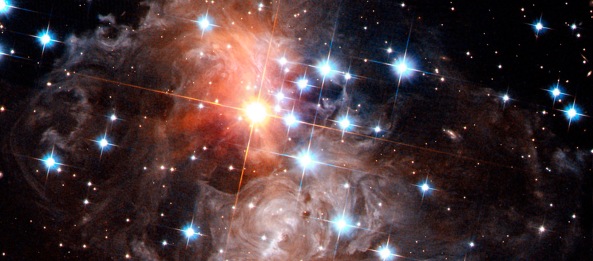“Our planet, our society, and we ourselves are built of star stuff.”—Carl Sagan, Cosmos
Here’s an amazing fact for your next cocktail party: Every single atom in your body—the calcium in your bones, the carbon in your genes, the iron in your blood, the gold in your filling—was created in a star billions of years ago. All except atoms of hydrogen and one or two of the next lightest elements. They were formed even earlier, shortly after the Big Bang began 13.7 billion years ago.
 As hard as it might be to believe, every atom in your body, astrophysicists say, originated billions of years ago in a star or in the explosive aftermath of the Big Bang. Here, a close-up of Polaris, the North Star. EnlargePhoto credit: NASA, ESA, G. Bacon (STScI)
As hard as it might be to believe, every atom in your body, astrophysicists say, originated billions of years ago in a star or in the explosive aftermath of the Big Bang. Here, a close-up of Polaris, the North Star. EnlargePhoto credit: NASA, ESA, G. Bacon (STScI)
It’s true, according to astrophysicists. You and everything around you, every single natural and man-made thing you can see, every rock, tree, butterfly, and building, comprises atoms that originally arose during the Big Bang or, for all but the lightest two or three elements, from millions of burning and exploding stars far back in the history of the universe. You live because stars died; it’s that simple.
How is this so? How can you possibly be a walking galaxy of fossil stardust? Well, the story is not a new one, but it bears retelling, if only because its working out was one of the finest achievements of 20th-century astrophysics—and because it’s so astonishing.
The start of it all
The story begins at the beginning, as in the Big Bang. That is when, astrophysicists say, all the hydrogen in the universe came into being. Initially it was just protons, and then, as the young universe expanded and cooled, these became bound to electrons, forming hydrogen atoms. The very hydrogen atoms in the H2O that makes up over half your body were born then. They didn’t come from your parents; they came from the early universe. Did you have any idea you have atoms in your body that are over 13 billion years old?
If you could separate one hydrogen atom from one molecule of water in your body, shrink down to its atomically tiny size like the scientists in Fantastic Voyage, then reverse time and follow it back to through its unimaginable lifetime, you would find yourself in the immediate aftermath of the Big Bang. That very hydrogen atom, an atom now inside you as you read this, has remained unchanged since the beginning of time.
 Over 13 billion years since the Big Bang, hydrogen and helium still make up most of the visible matter in the universe. Nearly 10,000 galaxies appear in this Hubble Ultra Deep Field image. EnlargePhoto credit: NASA, ESA, and N. Pirzkal (STScI/ESA)
Over 13 billion years since the Big Bang, hydrogen and helium still make up most of the visible matter in the universe. Nearly 10,000 galaxies appear in this Hubble Ultra Deep Field image. EnlargePhoto credit: NASA, ESA, and N. Pirzkal (STScI/ESA)
The Big Bang also churned out helium, the next lightest element. You don’t have any helium in you, unless you just sucked the gas out of a birthday balloon. But helium is the second most common element after hydrogen. Together they make up more than 98 percent of the matter in the universe. (Luminous matter, that is; dark matter is a whole other story.) A smattering of lithium (element 3) and one or two other of the lightest elements also formed in the Bang, but these were negligible.
Everything else, every other chemical element, including carbon, oxygen, nitrogen, and all the other elements essential for your life, is thought to have been fabricated in stars.
How? Well, the story is either simple or horrendously complex depending on whether you’re a science writer or a scientist. Here’s the simple story:
Table for 118
First, what are we talking about when we talk about an element? A chemical element is a substance that cannot be broken down or changed into another substance using chemical means. It can be changed using nuclear means, which is what happens inside stars.
Every second, the sun converts about 500 million tons of hydrogen into helium.
As we learn in high school chemistry—and can remind ourselves with a quick glance at the Periodic Table—hydrogen, the lightest element, has one proton in its nucleus and thus is given the atomic number 1. Helium has two protons and so is number 2, and so on all the way up to uranium, which, with 92 protons in its nucleus, is the heaviest of the “naturally occurring” elements.
Remarkably, all life on Earth, all everything we see around us, consists of various combinations of those 92 elements. There are still heavier elements, ranging from neptunium (93) all the way up to the unofficially named ununoctium (118), though with the exception of trace amounts of neptunium and plutonium (94), these are not found naturally on Earth.
Read more:
http://www.pbs.org/wgbh/nova/space/star-in-you.html
Similar:
http://thespiritscience.net/2014/10/02/this-is-the-secret-of-the-stars/
